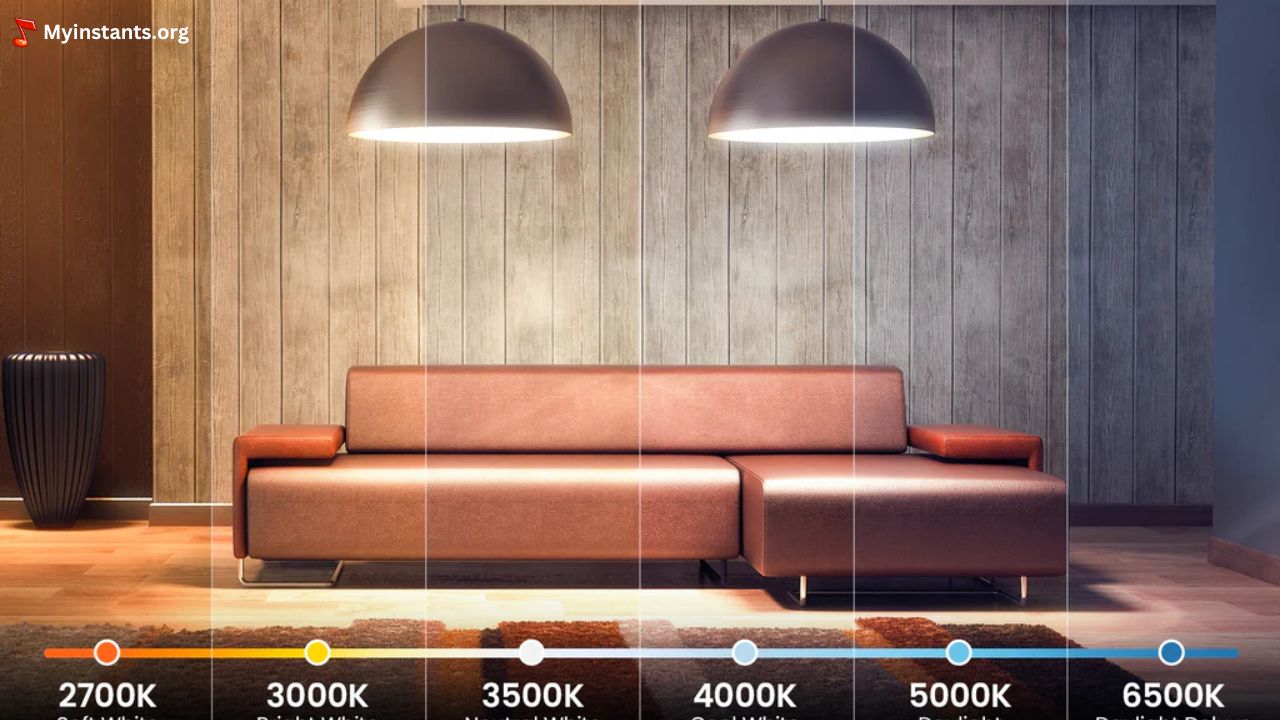Are you confused between cool white and daylight bulbs? Need help deciding which one to choose or which is brighter? If you can relate to these questions, this guide is for you.
We need lighting not only to illuminate spaces but also to ensure safety and functionality in our surroundings. It helps enhance clarity and makes seeing and performing our tasks more manageable. Due to the invention of light bulbs, we can carry on with our activities even at night. However, choosing the correct bulb can be tricky.
One of the most common challenges people face is choosing the right color temperature. This refers to the tone of the light emitted by the bulb, and two popular options are cool white and daylight bulbs. Though they may seem similar, they are different, especially when it comes to influencing the atmosphere of a room.
Cool white bulbs produce a crisp, clean light with a bluish tint, while daylight bulbs mimic natural daylight. Choosing between these two can be confusing, so we are here to help. We have laid down a daylight vs excellent white comparison guide to highlight the main differences. Our guide can help you pick the right option for your home or workspace.
Cool White vs Daylight Bulbs: Which One Should You Choose?
Lighting technology has indeed come a long way. Today, we have a wide range of options, including colored lights. Since lighting is a crucial part of our lives, it is essential to choose the right type. But sometimes, even a simple thing like choosing a light type may seem challenging, especially if you need more knowledge.
When buying a new light, you will come across many options, including cool white vs daylight. If you think of sticking with traditional filament bulbs, it’s time to reconsider your choice. Modern lighting offers versatility in both intensity and color. Plus, you can choose from various styles and shapes to suit your needs.
Among the most popular options are cool white vs daylight bulbs. But the question arises: which is better? To make an informed decision, it’s essential to understand their differences. Let’s dive into it.
Also see: Is Crypto30x.com Blockchain Good For Crypto Investors?
What Is Cool White Lighting?
Cool white lighting is typically around 4000K and offers a balanced blend of clarity and brightness. This makes it a versatile choice for various spaces in the home. The good thing about cool white light bulbs is that they are bright and clear, making them useful in areas where visibility is crucial.
For example, it helps when shaving or applying makeup in bathrooms by providing a clearer view. In kitchens, it can enhance visibility for cooking, and in studies, it creates an environment that promotes focus and productivity.
One of the benefits of cool white lighting is its modern and clean appearance. Its slightly bluish hue adds a fresh and contemporary feel to a space. This is why they are widely used in sleek, modern designs. Additionally, installing cool white lights with dimmers allows you to adjust the brightness level and, thus, reduce harshness when needed.
In short, cool white lighting is excellent for areas where brightness and energy are needed. It’s a go-to option for those who want a modern aesthetic while ensuring functionality in critical areas of the home.
What Is Daylight Lighting?
Daylight lighting is usually above 5000K and can be pretty intense. It has a bright, white appearance that mimics natural sunlight. However, this type of lighting can sometimes feel harsh, especially in a home setting.
Many people find the solid blue tint of daylight lighting overpowering in areas like bedrooms or living rooms. Its intensity can even lead to headaches in some people.
However, daylight lighting is highly effective in work environments like studios, offices, or warehouses, where productivity is essential. The bright, crisp light energizes people, making it a good choice for high-activity areas. It also helps stimulate the brain, which is why it is used in places where concentration is critical.
Although artificial daylight bulbs are not a perfect replacement for natural sunlight, daylight LEDs are the closest option available. They provide a natural-looking brightness without the bluish hue in cool white lights. For spaces that require precise, vibrant lighting, such as home offices or task-specific areas, daylight LEDs can be a great option.
Also see: Why is my AULA Keyboard Light Lighting Up? [Solved]
Comparing Cool White vs Daylight
Now let’s talk about cool white vs daylight light bulbs. Before you make a selection, it is essential to understand the difference between the two.
Appearance
When you switch on a cool white or daylight bulb, you are likely to notice the difference between their appearance.
A cool white bulb emits intense, bright light and is neutral white with a slight hint of blue. This makes it suitable for areas where clarity and brightness are essential.
On the other hand, daylight bulbs have a bluish-white hue, similar to natural daylight, especially during midday. This color creates a more comfortable viewing experience and helps reduce eye strain.
Effect On Mood
Lighting indeed has a significant effect on our mood and performance. Daylight bulbs, which replicate the brightness of the midday sun, can create a similar uplifting effect as spending time outdoors. Using these light bulbs during the day can boost your energy levels, alertness, and positivity. This is why they are used in classrooms, offices, and other professional environments.
Cool white bulbs also energize and increase focus but without the intensity of daylight bulbs. Their clean, bright light enhances visibility and reduces eye strain. These light bulbs help promote a positive and productive environment in workspaces. They help prevent mental fatigue and maintain focus while creating a tidy, organized feel in the room.
Effect On Eyesight
While warmer light temperatures are generally more accessible to the eyes, the impact of both daylight and cool white bulbs on eye comfort varies.
Daylight bulbs mimic natural sunlight, which helps reduce eye strain and provides a more relaxed viewing experience. The good thing is that they help improve mood and energy. However, their intense blue hue may feel overwhelming, especially in relaxing spaces.
On the other hand, cool white bulbs are gentler on the eyes in evening settings. It is also a good option for people who are sensitive to light. However, their bright light can become harsh over time, leading to eye strain and fatigue.
The answer for those wondering, “Daylight vs cool white, which is better for eyes?” is none. Both types are not ideal for long-term eye health. However, the unique qualities of these light bulbs make them suitable for specific situations. You should consider your requirements and preference when choosing between cool requirements daily preferences
Light Temperature
Light temperature is measured in Kelvin; the higher the Kelvin rating, the cooler and brighter the light appears.
For example, daylight bulbs have a color temperature ranging from 5500 to 6500 Kelvins. These bulbs produce light that closely resembles natural sunlight. This makes them ideal for spaces like workshops, offices, or kitchens.
On the other hand, cool white bulbs have a lower color temperature between 3000 and 4500 Kelvins. This cooler temperature creates a softer, more neutral light with a slight blue tone. In other words, they are less intense than daylight bulbs.
In short, daylight bulbs are brighter because they have a higher temperature than cool white bulbs.
Light Color Tone
Another critical difference between cool white vs daylight bulbs is their color tone. The light’s tone, or hue, impacts how it feels in a room.
Cool white bulbs produce a light with a subtle blue tint, making it feel crisp and energetic. On the other hand, daylight bulbs don’t have any blue hues. It is more natural and balanced.
When you compare cool white with warm white light, cool white is brighter because of the blue tint, while warm light has more of an orange or yellow hue, which gives it a softer, cozier feel.
Brightness
Brightness is a significant factor when deciding between cool white vs daylight bulbs factor. Light brightness is determined by three main things: lumens, wattage, and color intensity.
Lumens measure how much light you can see, while wattage refers to the amount of power the bulb uses. Color Intensity is the color of the light that impacts the brightness.
To put things into perspective, daylight bulbs are brighter because they have higher lumens and color temperatures. Cool white lights are also colorful but not as bright as daylight bulbs. You can choose between the two based on the mood you want to create in a room.
Also see: Is 300 Mbps Fast? Real Download Speed & Is it Enough?
Applications Of Cool White vs Daylight Bulbs
Choosing between cool white vs daylight bulbs largely depends on the setting and purpose. Here’s how both types of bulbs apply in different environments:
Kitchen Use
Cool white bulbs are an excellent choice for the kitchen because they offer clear, bright light, which is helpful when cooking or cleaning. They allow you to see details clearly, reducing strain on your eyes.
On the other hand, daylight bulbs tend to be brighter and may seem too intense in a kitchen setting. However, they can be helpful in areas where accurate color visibility is needed.
Bathroom Use
Cool white bulbs work well in bathrooms, especially when shaving, grooming, or applying makeup. Their crisp light helps you see yourself clearly, making the colors more accurate.
Although daylight bulbs provide good lighting, they sometimes feel too bright for smaller bathroom spaces. However, they are ideal when accurate color rendering is necessary.
Offices and Workspaces
Cool white bulbs are often favored in offices because they provide a balanced brightness level. This helps reduce glare on screens, making them easier to work with. They also improve contrast and keep employees focused and alert throughout the day.
Daylight bulbs can also be used but may sometimes feel too harsh for indoor office settings, depending on the nature of the work.
Sports Fields
For outdoor activities like sports, daylight bulbs are the best option. Their natural, bluish-white light resembles daylight and helps improve visibility and color accuracy on the field. This is beneficial for both players and spectators.
Cool white bulbs can also be used as they provide a balanced, bright light. However, daylight bulbs usually offer better performance for sports.
Also see: Top 70+ Hot South Indian Actress Name List With Photos
Final Words
Choosing between cool white vs daylight depends on the type of atmosphere you want to create. Cool white bulbs provide a modern, clean light that works well in kitchens, bathrooms, and offices, while daylight bulbs offer a brighter, more natural light suited for workspaces and areas where productivity is critical. By understanding the differences between these two lighting options, you can choose the one that best fits your needs.
Also see: Myinstants – Meme SoundBoard & Sound Buttons
FAQs
Is cool white better than daylight?
Cool white and daylight have different color temperatures and brightness. Daylight is ideal for work areas, while cool white is preferable in relaxation areas.
Is cool white or daylight better for the eyes?
Cool white is easier on the eyes, but daylight is not.
What is the difference between daylight white and bright white?
Daylight white has a cooler, bluish tone, similar to sunlight, while bright white is warmer and more neutral with a softer light.
Should I use daylight bulbs in the kitchen?
Daylight bulbs are an excellent choice for kitchens, providing a bright, clear light that helps with visibility and focus.
Which light is best for study?
Daylight or cool white lights are best for studying. They offer a clear, bright light that reduces eye strain and helps you stay focused for long periods.
Is cool white good for the bedroom?
Cool white suits the bedroom if you prefer a clean, crisp look.
For more such interesting content, keep reading Myinstants Blog.



